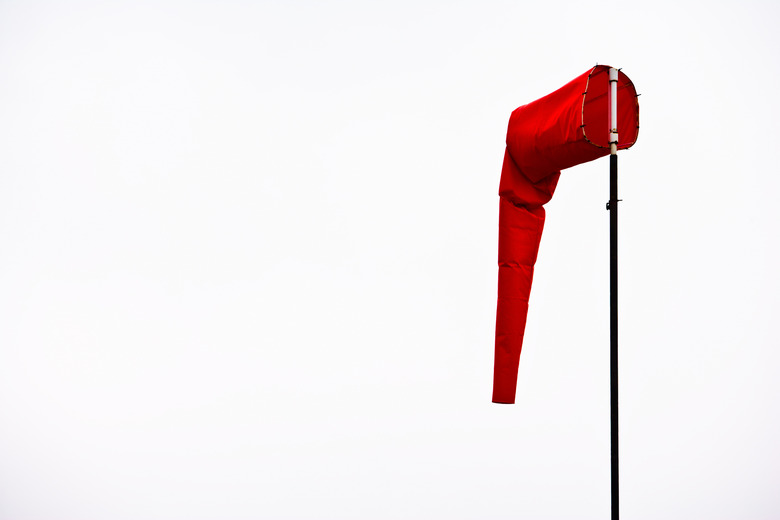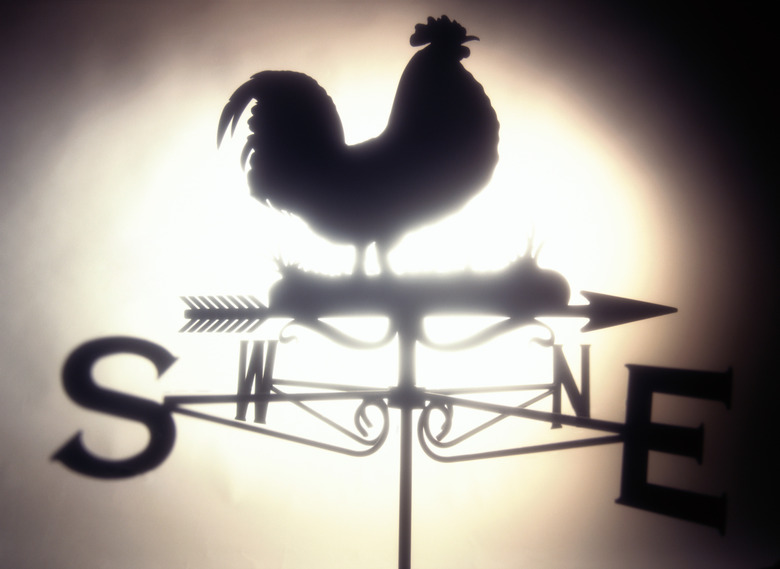Windsock Vs. Wind Vane
Windsocks and wind vanes — also called weather vanes — both show the direction the wind is blowing. For example, wind vanes and windsocks might indicate a southerly wind meaning that the wind is blowing from the south. Extensive information about the wind direction and speed is collected from weather stations throughout the world and available online. But with a quick glance, these simple instruments give first-hand knowledge of wind direction. Wind or weather vanes and windsocks differ in shape. Often, we associate windsocks with airports and wind vanes with the tops of old barns.
Uses
Uses
Through the years, the information provided by wind wanes and windsocks remains important to ship captains, farmers, pilots and fishermen. For example, farmers, especially in isolated areas, traditionally rely on wind vanes to aid in weather prediction. The Federal Aviation Administration creates standards for the use of wind socks at airports. Pilots at airports without towers check windsocks before taking off and landing to see how to adjust their controls for wind. Some manufacturing plants utilize wind socks to detect the release of dangerous gases.
Wind Vanes
Wind Vanes
Usually mounted on top of barns or houses, wind vanes consist of some type of arrow that rotates freely on top of a vertical rod. A roof-type mount allows a free-moving arrow. As the wind shifts direction, the point of the arrow shifts. The arrow points in the direction the wind is blowing. Wind vanes range from simple arrows to elaborate handcrafted arrow-shaped objects. Metal trotting horses, roosters, ships, fish and eagles sit atop arrows to indicate wind direction. Wind vanes often serve as ornaments to adorn a building.
Wind Vane Shape
Wind Vane Shape
The tail end of the arrow on the wind vane usually has a larger surface area than the pointed end. When wind blows, the tail end has a greater resistance to the wind than the pointed end. This rotates the arrow so the arrow points in the direction from which the wind is blowing.
Windsocks
Windsocks
Air sleeves, air socks, wind cones, and wind sleeves are other names for windsocks. Often constructed of fabric, windsocks have a cone shape. They are attached to a mounting pole. Wind flows into the wide end of the cone and out the narrow end. The narrow end extends in the opposite direction from which the wind is blowing. For example, when the narrow end of the windsock is pointing north, the wind is blowing from the south. In addition to determining wind direction, windsocks also give an indication of wind speed. During a strong breeze, the windsock flies almost horizontally to the ground. With a mild breeze, the windsock extends at a 45-degree angle to the ground. Under calm conditions, the windsock droops next to the mounting pole.
Cite This Article
MLA
Dieter, Kim. "Windsock Vs. Wind Vane" sciencing.com, https://www.sciencing.com/windsock-vs-wind-vane-23903/. 24 April 2017.
APA
Dieter, Kim. (2017, April 24). Windsock Vs. Wind Vane. sciencing.com. Retrieved from https://www.sciencing.com/windsock-vs-wind-vane-23903/
Chicago
Dieter, Kim. Windsock Vs. Wind Vane last modified March 24, 2022. https://www.sciencing.com/windsock-vs-wind-vane-23903/

